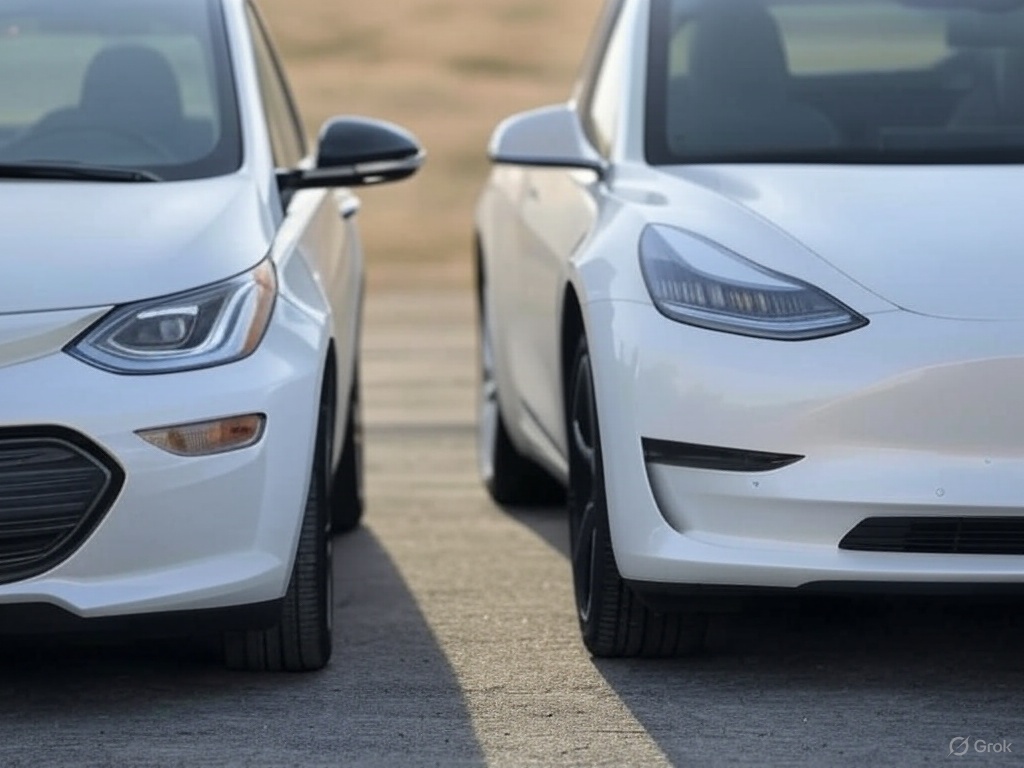Tesla model 3 vs Chevrolet Bolt EV – Why the Bolt EV is a better electric car for many people
I am the owner of a white Chevrolet Bolt EV (Opel Ampera-e) since 2020. I would like to share my top reasons why I think the Bolt EV is the better electric car for many people compared to a Tesla. Whether the Chevrolet Bolt EV (or its European counterpart, the Opel Ampera-e) is “better” than a Tesla depends on your priorities, as both have distinct strengths and weaknesses. Since “Tesla” could refer to various models (e.g., Model 3, Model Y, Model S), I’ll assume a comparison with the Tesla Model 3, the most comparable in price and size to the Bolt EV, and highlight where the Bolt might stand out.
5 reasons why the Chevy Bolt EV is a better electric car than a Tesla Model 3:
1. Price and Affordability
The Bolt EV has a significant edge in cost. As of its last production year (2023 in the U.S.), the Bolt EV started at around $26,500 before incentives, making it one of the most affordable EVs with decent range. In contrast, the Tesla Model 3 starts at $38,990 (as of early 2025 U.S. pricing), and that’s for the base Rear-Wheel Drive version. Even with potential tax credits, the Bolt EV typically undercuts the Model 3 by $10,000 or more, offering better value for budget-conscious buyers. If your goal is to get into an EV without breaking the bank, the Bolt EV wins hands down.
2. Practical Design
The Bolt EV’s hatchback design is a practical advantage over the Model 3’s sedan layout. With 16.6 cubic feet of cargo space behind the rear seats (expanding to 57 cubic feet with seats folded), it’s more versatile for hauling groceries, gear, or small furniture. The Model 3 offers 19.8 cubic feet total (including the frunk), but its trunk-only rear access is less flexible. The Bolt’s taller profile also means easier entry/exit and better visibility, which suits daily drivers or families needing a no-fuss, utilitarian EV.
3. Range for the Price
The Bolt EV delivers an EPA-estimated 259 miles of range from its 65 kWh battery, which is impressive for its price point. The base Model 3 offers 272 miles (2025 estimate), only slightly more, but costs significantly extra. Historically, the Bolt’s range-to-price ratio has been a standout—when it launched in 2016, it beat the Model S’s base range (then around 210 miles) for half the cost. While Tesla has since improved, the Bolt EV still punches above its weight for affordability-minded buyers needing solid range.
4. Charging and Maintenance Accessibility
The Bolt EV uses the CCS charging standard, widely supported by public networks like Electrify America, and doesn’t rely on a proprietary system like Tesla’s Superchargers. This can be an advantage in regions with sparse Supercharger coverage or for those who prefer flexibility. Additionally, being a General Motors product, the Bolt benefits from a broader service network—dealerships are more common than Tesla service centers, potentially simplifying repairs or maintenance, especially in rural areas.
5. Simplicity and Reliability
The Bolt EV offers a straightforward driving experience without the tech-heavy complexity of Tesla’s Autopilot or massive touchscreens. Its 10.2-inch infotainment screen and physical buttons contrast with the Model 3’s all-in-one 15-inch display, which some find distracting. While Tesla’s tech is cutting-edge, the Bolt’s conventional approach may appeal to those who want an EV without a steep learning curve. Reliability data is mixed, but the Bolt’s simpler design has fewer electronic variables to fail, though it did face a major battery recall (resolved by replacements).
6. Where Tesla Outshines the Bolt
To be fair, Tesla’s Model 3 excels in performance (0-60 mph in as little as 5.8 seconds for the base model vs. the Bolt’s 6.5 seconds), efficiency (134 MPGe combined vs. 120 MPGe), and fast-charging (up to 170 miles in 30 minutes via Superchargers vs. the Bolt’s 100 miles at 55 kW). Tesla’s Supercharger network remains unmatched for long-distance travel, and its software updates keep it ahead in features like semi-autonomous driving.
Conclusion and your feedback
The Chevrolet Bolt EV is “better” than a Tesla if your priorities are affordability, practical cargo space, and a simpler ownership experience with wider service support. It’s a no-nonsense EV that delivers great range for the money, ideal for urban commuters or budget buyers. However, if you value performance, cutting-edge tech, or long-road-trip convenience, Tesla’s Model 3 pulls ahead. What matters most to you—cost, utility, or tech? That’ll decide which is truly “better” for you. Let me know what you think in the comments and please subscribe to my YouTube channel so I can make more content like this.

